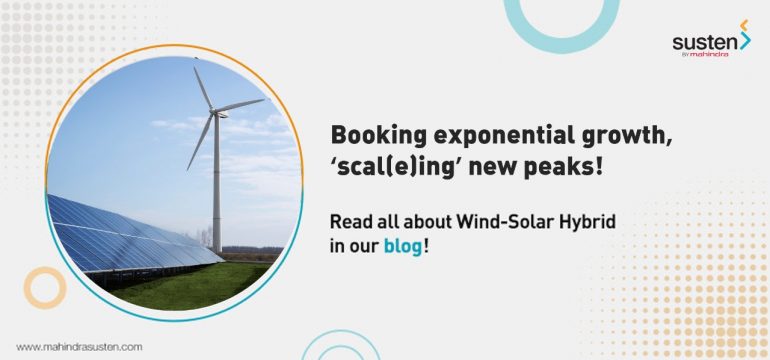Marrying the forces of the Sun and the Wind
Read all about Wind-Solar Hybrid: India’s Next Wave of Renewable Energy Growth
It’s 2021…already!! A lot has transpired in the year gone by and while we are all eager to move over the past, there are some important learnings from this decade that require our urgent attention. Climate change is perhaps one of the biggest challenge and one way to mitigate its adverse effects is through embracing renewable energy. While we’ve made significant progress in our journey towards adapting to clean energy (installed capacity of renewable energy in India stands at 90GW, as per MNRE), we still have a long way to go before it yields lasting results.
That renewable energy will form the crux of our future, is sort of given in today’s day and age. Our past and present has presented enough evidence that if we do not reduce our dependency on fossil fuels, and do not contain our carbon emissions, our planet will be in deep trouble in the years to come. However, the road to redemption (if we may say so) is one that is fraught with several challenges.
A recent report by the Climate Policy Initiative shed some light on the challenges the renewable sector has been facing off late. The report highlighted financial weakness of discoms, changing monsoon patterns, trouble with land availability & subsequent acquisition, payment delays and a substantial increase in market risks as some of compelling factors that call for swift action.
All things considered, switching from conventional (read polluting) means to power modernization to adopt more planet-friendly options require constant innovation and hi-speed implementation.
One such innovative concept that is in the limelight right now is Wind-Solar Hybrid, which is fast emerging as the viable new renewable energy system in India.
As the name suggests, the concept aims to harness both wind and solar energy in order to extract the best of both worlds – maximize energy generation and ensure good returns on the investment.
Wind-Solar Hybrid (WSH) Parks
Solar power projects are built on continuous and vast areas of land while wind power projects require scattered land. This basic difference in requirement increases transmission cost and crops up additional challenges in terms of land related issues. In scenarios like these, the WSH Parks, with proper infrastructure, can come to the rescue and speed up installation of renewable power projects in the country. To further propel this change, the government has proposed a unique ‘plug and play’ solution. To explain this solution in a nutshell: The wind energy park will enable investors to install wind and wind-solar power projects with ease. If the sites that are identified for the parks — with the help of the National Institute of Wind Energy (NIWE) – are found to be suitable, the park developer may consider developing a wind-solar hybrid park (after the concerned state government’s approvals). The seven states where sites have been identified are Tamil Nadu, Andhra Pradesh, Karnataka, Telangana, Gujarat, Rajasthan and Madhya Pradesh.
The new WSH scheme, proposed by the MNRE, highlights beneficial details of the parks:
- The total potential capacity of WSH in India as per the proposed scheme is 53,495MW.
- According to MNRE document, wind potential areas with more than 30% capacity utilization factor (CUF) will be considered for such projects. Each park capacity should be 500 MW or more, with the possibility of parks with lower capacity.
- Non availability of land often poses a major challenge in the smooth take off, of these projects. In a bid to overcome this hurdle, the state government will select the park and site for developers.
- Furthermore, the state government will charge Rs 0.05 /kWh of electricity that is exported to other states by the project developer.
- Leaving no stone unturned to ensure that this project is a success, MNRE will provide Rs 20 lakh per megawatt as financial assistance to park developers. This amount will be utilized by developers to prepare the sites (land acquisition, transmission connectivity and legal approvals) for wind plant installations.
In conclusion:
India has a herculean task at hand of achieving 175GW of renewable energy and it is policies like these which go a long way in paving the way to achieve this target. India has high potential of both wind and solar resources across various locations, and the WSH aims to harness both these energies to create a viable new renewable energy structure in the country. The Ministry of New and Renewable Energy adopted the National Wind-Solar Hybrid Policy in 2018 to promote setting up of WSH power plants. This policy also provides waivers and incentives to developers and some state governments such as that of Gujarat, Andhra Pradesh and Rajasthan have also come up with their own WSH policies. Taking these progressive measures a step further, MNRE, in October 2020, came up with WSH Bidding Guidelines. These guidelines will facilitate the tendering process and mitigate certain risks that were highlighting by the bidders. This move will give a much required boost to the RE sector and open up new avenues for developers, especially foreign players, looking to set up innovative projects. These mechanisms will also tackle many site, land and evacuation related risks that are constantly plaguing developers.
All in all, the WSH seems to be taking steps in the right direction to achieve a carbon neutral economy.

